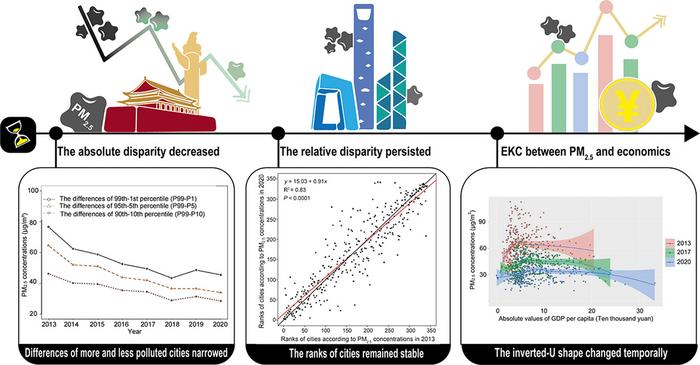PM2.5 (particulate matter less than 2.5 micrometers in diameter) is a critical pollutant affecting air quality and public health. In China, rapid industrialization and urbanization have led to severe PM2.5 pollution, posing significant health risks and environmental concerns. The Chinese government has implemented various clean air policies to tackle this issue, and the PM2.5 concentrations have dropped significantly in China since 2013. However, few studies have evaluated temporal trends of the spatial disparity in PM2.5 concentrations from 2013 to 2020 in China, and their associations with socioeconomic factors.
A pivotal study, published in Eco-Environment & Health (Volume 2, 2023), has examined the evolution of PM2.5 pollution disparity in China from 2013 to 2020, revealing both progress and persistent challenges in air quality management.
This study used high-resolution data to analyze the temporal trends of the spatial disparity in PM2.5 concentrations and their relationship with economic factors across China from 2013 to 2020. The difference in PM2.5 between highly and less polluted areas decreased, indicating that the absolute disparity decreased over time. However, cities with high PM2.5 levels in 2013 remained heavily polluted in 2020, and vice versa, suggesting that the relative disparity persisted.
The study also found an inverted U-shaped relationship between PM2.5 levels and economic development in China. Overall, economic growth initially worsens air quality before potentially leading to improvement once a certain threshold is reached. The negative effects in less-developed regions tended to diminish over time, and economic development tended to promote cleaner air in developed areas of China. This finding aligns with the Environmental Kuznets Curve theory.
The study’s lead researcher, Dr. Xia Meng, highlighted the importance of understanding PM2.5 disparities to inform targeted air quality improvement strategies and promote environmental equality.
This research provides critical insights for policymakers to develop nuanced strategies that address both economic growth and environmental protection. It underscores the need for region-specific air quality policies. The study marks a significant step in understanding the dynamics of PM2.5 pollution in China and sets a foundation for future efforts to achieve environmental justice and health equity.

Credit: Eco-Environment & Health
PM2.5 (particulate matter less than 2.5 micrometers in diameter) is a critical pollutant affecting air quality and public health. In China, rapid industrialization and urbanization have led to severe PM2.5 pollution, posing significant health risks and environmental concerns. The Chinese government has implemented various clean air policies to tackle this issue, and the PM2.5 concentrations have dropped significantly in China since 2013. However, few studies have evaluated temporal trends of the spatial disparity in PM2.5 concentrations from 2013 to 2020 in China, and their associations with socioeconomic factors.
A pivotal study, published in Eco-Environment & Health (Volume 2, 2023), has examined the evolution of PM2.5 pollution disparity in China from 2013 to 2020, revealing both progress and persistent challenges in air quality management.
This study used high-resolution data to analyze the temporal trends of the spatial disparity in PM2.5 concentrations and their relationship with economic factors across China from 2013 to 2020. The difference in PM2.5 between highly and less polluted areas decreased, indicating that the absolute disparity decreased over time. However, cities with high PM2.5 levels in 2013 remained heavily polluted in 2020, and vice versa, suggesting that the relative disparity persisted.
The study also found an inverted U-shaped relationship between PM2.5 levels and economic development in China. Overall, economic growth initially worsens air quality before potentially leading to improvement once a certain threshold is reached. The negative effects in less-developed regions tended to diminish over time, and economic development tended to promote cleaner air in developed areas of China. This finding aligns with the Environmental Kuznets Curve theory.
The study’s lead researcher, Dr. Xia Meng, highlighted the importance of understanding PM2.5 disparities to inform targeted air quality improvement strategies and promote environmental equality.
This research provides critical insights for policymakers to develop nuanced strategies that address both economic growth and environmental protection. It underscores the need for region-specific air quality policies. The study marks a significant step in understanding the dynamics of PM2.5 pollution in China and sets a foundation for future efforts to achieve environmental justice and health equity.
###
References
DOI
10.1016/j.eehl.2023.08.007
Original Source URL
https://doi.org/10.1016/j.eehl.2023.08.007
Funding information
The National Key Research and Development Program of China (2022YFC3702705); The National Natural Science Foundation of China (82003413, 92043301 and 82030103).
About Eco-Environment & Health
Eco-Environment & Health (EEH) is an international and multidisciplinary peer-reviewed journal designed for publications on the frontiers of the ecology, environment and health as well as their related disciplines. EEH focuses on the concept of “One Health” to promote green and sustainable development, dealing with the interactions among ecology, environment and health, and the underlying mechanisms and interventions. Our mission is to be one of the most important flagship journals in the field of environmental health.
Journal
Eco-Environment & Health
DOI
10.1016/j.eehl.2023.08.007
Subject of Research
Not applicable
Article Title
Evolution in disparity of PM2.5 pollution in China
Article Publication Date
12-Oct-2023
COI Statement
The authors declare that they have no competing interests




